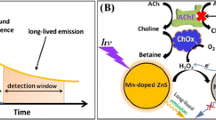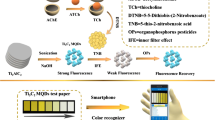Abstract
Terbium-based metal–organic frameworks (Tb-MOF) prepared under mild conditions was utilized to construct a fluorescence probe for determination of organophosphorus pesticides (OPs) coupled with acetylcholinesterase (AChE), acetylcholine chloride (Ach), and choline oxidase (CHO). Since OPs have obvious inhibition on the activity of AChE in the Tb-MOF/ACh/CHO/AChE system, the detection of OPs was accomplished by restoring the fluorescence of Tb-MOF resulting from reduced production of H2O2. By taking chlorpyrifos (CPF) as a pesticide model, the method exhibits high sensitivity in the linear range 0.1–4.0 μg·L−1 with the limit of detection (LOD) of 0.04 μg·L−1 under optimum conditions (λex = 280 nm, λem = 544 nm). The Tb-MOF/ACh/CHO/AChE fluorescence system has high selectivity for CPF. The method was successfully applied to the detection of CPF in tap water and strawberry samples (recovery of 87.36–115.60% for tap water and 95.04–103.20% for strawberry). Free from complicated fabrication operation, the Tb-MOF-based system is rapid, simple, and stable, which provides a reference and new way for the design of OPs fluorescent probes in the future.
Graphical abstract







Similar content being viewed by others
References
Arduini F, Cinti S, Scognamiglio V et al (2016) Nanomaterials in electrochemical biosensors for pesticide detection: advances and challenges in food analysis. Microchim Acta 183(7):2063–2083. https://doi.org/10.1007/s00604-016-1858-8
Tseng WB, Hsieh MM, Chen CH et al (2020) Functionalized gold nanoparticles for sensing of pesticides: a review. J Food Drug Anal 28(4):521–538. https://doi.org/10.38212/2224-6614.1092
Huang YH, Zhang WP, Pang SM et al (2021) Insights into the microbial degradation and catalytic mechanisms of chlorpyrifos. Environ Res 194:110660. https://doi.org/10.1016/j.envres.2020.110660
ZH Qing, YC Li, YN Li et al (2020) Thiol-suppressed I-2-etching of AuNRs: acetylcholinesterase-mediated colorimetric detection of organophosphorus pesticides. Microchim Acta 187(9):497. https://doi.org/10.1007/s00604-020-04486-2
Eaton DL, Daroff RB, Autrup H et al (2008) Review of the toxicology of chlorpyrifos with an emphasis on human exposure and neurodevelopment. Crit Rev Toxicol 38:1–125. https://doi.org/10.1080/10408440802272158
Xiang L, Tang JS (2017) QD-aptamer as a donor for a FRET-based chemosensor and evaluation of affinity between acetamiprid and its aptamer. RSC Adv 7(14):8332–8337. https://doi.org/10.1039/c6ra26118c
Sinha SN, Pal R, Dewan A et al (2006) Effect of dissociation energy on ion formation and sensitivity of an analytical method for determination of chlorpyrifos in human blood, using gas chromatography-mass spectrometer (GC-MS in MS/MS). Int J Mass Spectrom 253(1–2):48–57. https://doi.org/10.1016/j.ijms.2006.02.020
Mauldin RE, Primus TM, Buettgenbach TA et al (2006) A simple HPLC method for the determination of chlorpyrifos in black oil sunflower seeds. J Liq Chromatogr Relat Technol 29(3):339–348. https://doi.org/10.1080/10826070500451863
Zhang C, Wu YJ, Jin SF et al (2013) Analysis of chlorpyrifos and chlorpyrifos-methyl residues in multi-environmental media by cloud-point extraction and HPLC. Anal Methods 5(12):3089–3095. https://doi.org/10.1039/c3ay26623k
Wong JW, Zhang K, Tech K et al (2010) Multiresidue pesticide analysis of ginseng powders using acetonitrile- or acetone-based extraction, solid-phase extraction cleanup, and gas chromatography-mass spectrometry/selective ion monitoring (GC-MS/SIM) or -tandem mass spectrometry (GC-MS/MS). J Agric Food Chem 58(10):5884–5896. https://doi.org/10.1021/jf903851h
PL Wu, PS Wang, MY Gu, et al (2021) Human health risk assessment of pesticide residues in honeysuckle samples from different planting bases in China Sci Total Environ 759142747. https://doi.org/10.1016/j.scitotenv.2020.142747
Zhao SL, Xiao JN, Zheng TX et al (2019) Highly selective and sensitive detection of PO43- ions in aqueous solution by a luminescent terbium metal-organic framework. ACS Omega 4(15):16378–16384. https://doi.org/10.1021/acsomega.9b01911
Liu QJ, Wang H, Han P et al (2019) Fluorescent aptasensing of chlorpyrifos based on the assembly of cationic conjugated polymer-aggregated gold nanoparticles and luminescent metal-organic frameworks. Analyst 144(20):6025–6032. https://doi.org/10.1039/c9an00943d
Vojoudi H, Bastan B, Ghasemi JB et al (2019) An ultrasensitive fluorescence sensor for determination of trace levels of copper in blood samples. Anal Bioanal Chem 411(21):5593–5603. https://doi.org/10.1007/s00216-019-01940-w
Leila Arjomandi-Behzad, Mohammad Kazem Rofouei, Alireza Badiei, et al (2020) Simultaneous removal of crystal violet and methyl green in water samples by functionalised SBA-15. Int J Environ Anal Chem 1-17. https://doi.org/10.1080/03067319.2020.1804895
Bunzli JCG, Eliseeva SV (2013) Intriguing aspects of lanthanide luminescence. Chem Sci 4(5):1939–1949. https://doi.org/10.1039/c3sc22126a
Cui YJ, Chen BL, Qian GD (2014) Lanthanide metal-organic frameworks for luminescent sensing and light-emitting applications. Coord Chem Rev 273:76–86. https://doi.org/10.1016/j.ccr.2013.10.023
Zhang Z, Sang W, Xie LS et al (2019) Metal-organic frameworks for multimodal bioimaging and synergistic cancer chemotherapy. Coord Chem Rev 399:213022. https://doi.org/10.1016/j.ccr.2019.213022
Zeng XL, Long Z, Jiang XF et al (2020) Single bimetallic lanthanide-based metal-organic frameworks for visual decoding of a broad spectrum of molecules. Anal Chem 92(7):5500–5508. https://doi.org/10.1021/acs.analchem.0c00324
Cue Y, Chen F,Yin XB (2019) A ratiometric fluorescence platform based on boric-acid-functional Eu-MOF for sensitive detection of H2O2 and glucose. Biosens Bioelectron 135208-215. https://doi.org/10.1016/j.bios.2019.04.008
Yang H.W, Lu F.N, Zhan X.X, et al (2020) A Eu3+-inspired fluorescent carbon nanodot probe for the sensitive visualization of anthrax biomarker by integrating EDTA chelation. Talanta 208120368-120368. https://doi.org/10.1016/j.talanta.2019.120368
Cao LH, Shi F, Zhang WM et al (2015) Selective sensing of Fe3+ and Al3+ ions and detection of 2,4,6-trinitrophenol by a water-stable terbium-based metal-organic framework. Chem Eur J 21(44):15705–15712. https://doi.org/10.1002/chem.201501162
Chai HM, Zhang GQ, Jiao CX et al (2020) A multifunctional Tb-MOF detector for H2O2, Fe3+, Cr2O72-, and TPA explosive featuring coexistence of binuclear and tetranuclear clusters. ACS Omega 5(51):33039–33046. https://doi.org/10.1021/acsomega.0c04526
Liu QJ, Tang SX, Wang H et al (2022) Stereospecific recognition and rapid determination of D-amino acids in human serum based on luminescent metal-organic frameworks. New J Chem 46(17):8029–8036. https://doi.org/10.1039/d1nj05570d
Shivani U,Kumar S R (2018) Technological advancement in electrochemical biosensor based detection of organophosphate pesticide chlorpyrifos in the environment: a review of status and prospects. Biosens Bioelectron 11637-50. https://doi.org/10.1016/j.bios.2018.05.039
Feng L, Dong CL, Li MF, et al (2019) Terbium-based metal-organic frameworks: highly selective and fast respond sensor for styrene detection and construction of molecular logic gate. J Hazard Mater 388121816. https://doi.org/10.1016/j.jhazmat.2019.121816
Izadpanah M, Sarrafzadeh MH, Rezaei-Dashtarzhandi M et al (2020) Aquatic center sewage reclamation and water reuse, using an integrated system combining adsorption, RO membrane system, and TiO2/Fe3O4 photocatalytic oxidation. J Environ Chem Eng 9(1):104957. https://doi.org/10.1016/j.jece.2020.104957
Vojoudi H, Ghasemi JB, Hajihosseinloo A et al (2021) One-pot synthesis of hematite-alumina hollow sphere composite by ultrasonic spray pyrolysis technique with high adsorption capacity toward PAHs. Adv Powder Technol 32(4):1060–1069. https://doi.org/10.1016/j.apt.2021.02.015
Liu K, You HP, Zheng YH et al (2010) Room-temperature synthesis of multi-morphological coordination polymer and tunable white-light emission. Cryst Growth Des 10(1):16–19. https://doi.org/10.1021/cg900990w
Li XJ, Lu S, Tu DT et al (2020) Luminescent lanthanide metal-organic framework nanoprobes: from fundamentals to bioapplications. Nanoscale 12(28):15021–15035. https://doi.org/10.1039/d0nr03373a
Kaczmarek MT, Zabiszak M, Nowak M, et al (2018) Lanthanides: Schiff base complexes, applications in cancer diagnosis, therapy, and antibacterial activity. Coord Chem Rev 37042-54. https://doi.org/10.1016/j.ccr.2018.05.012
Yin HQ, Wang XY, Yin XB (2019) Rotation restricted emission and antenna effect in single metal-organic frameworks. J Am Chem Soc 141(38):15166–15173. https://doi.org/10.1021/jacs.9b06755
Lu Y, Wei M, Wang CC et al (2020) Enhancing hydrogel-based long-lasting chemiluminescence by a platinum-metal organic framework and its application in array detection of pesticides and D-amino acids. Nanoscale 12(8):4959–4967. https://doi.org/10.1039/d0nr00203h
Kaur R, Chhibber M, Mahata P et al (2018) Luminescence based detection of trinitrophenol and aromatic organophosphorous pesticides using a coordination polymer. J Mex Chem Soc 61(4):336–341. https://doi.org/10.29356/jmcs.v61i4.464
Lippert AR, De Bittner GCV, Chang CJ (2011) Boronate oxidation as a bioorthogonal reaction approach for studying the chemistry of hydrogen peroxide in living systems. Acc Chem Res 44(9):793–804. https://doi.org/10.1021/ar200126t
Xu GW, Wu YP, Dong WW et al (2017) A multifunctional Tb-MOF for highly discriminative sensing of Eu3+/Dy3+ and as a catalyst support of Ag nanoparticles. Small 13(22):1602996. https://doi.org/10.1002/smll.201602996
Wu YP, Xu GW, Dong WW et al (2017) Anionic lanthanide MOFs as a platform for iron-selective sensing, systematic color tuning, and efficient nanoparticle catalysis. Inorg Chem 56(3):1402–1411. https://doi.org/10.1021/acs.inorgchem.6b02476
Ju P, Zhang E, Jiang L et al (2018) A novel microporous Tb-MOF fluorescent sensor for highly selective and sensitive detection of picric acid. RSC Adv 8(39):21671–21678. https://doi.org/10.1039/c8ra02602e
Hajihosseinloo A, Dehkordi AB, Vojoudi H et al (2022) N-Doped carbon hollow spheres for the simultaneous determination of atorvastatin and amlodipine by synchronous fluorescence spectroscopy. Microchem J 172:106983. https://doi.org/10.1016/j.microc.2021.106983
Sun X, Cao YY, Gong ZL et al (2012) An amperometric immunosensor based on multi-walled carbon nanotubes-thionine-chitosan nanocomposite film for chlorpyrifos detection. Sensors 12(12):17247–17261. https://doi.org/10.3390/s121217247
Soongsong J, Lerdsri J, Jakmunee J (2021) A facile colorimetric aptasensor for low-cost chlorpyrifos detection utilizing gold nanoparticle aggregation induced by polyethyleneimine. Analyst 146(15):4848–4857. https://doi.org/10.1039/d1an00771h
Gaviria MI, Barrientos K, Arango JP et al (2022) Highly sensitive fluorescent biosensor based on acetylcholinesterase and carbon dots-graphene oxide quenching test for analytical and commercial organophosphate pesticide detection. Front Environ Sci 10:825112. https://doi.org/10.3389/fenvs.2022.825112
Guo Y, Liu H, Chen D et al (2020) High recycling Fe3O4-CdTe nanocomposites for the detection of organophosphorothioate pesticide chlorpyrifos. Green Energy Environ 7(2):229–235. https://doi.org/10.1016/j.gee.2020.09.001
Funding
This work was sponsored by the Youth Fund Project from Beijing Academy of Agricultural and Forestry Sciences (QNJJ202114).
Author information
Authors and Affiliations
Corresponding authors
Ethics declarations
Conflict of interest
The authors declare no competing interests.
Additional information
Publisher's note
Springer Nature remains neutral with regard to jurisdictional claims in published maps and institutional affiliations.
Supplementary Information
Below is the link to the electronic supplementary material.
Rights and permissions
Springer Nature or its licensor (e.g. a society or other partner) holds exclusive rights to this article under a publishing agreement with the author(s) or other rightsholder(s); author self-archiving of the accepted manuscript version of this article is solely governed by the terms of such publishing agreement and applicable law.
About this article
Cite this article
Zhang, Z., Zhang, L., Han, P. et al. A luminescent probe based on terbium-based metal–organic frameworks for organophosphorus pesticides detection. Microchim Acta 189, 438 (2022). https://doi.org/10.1007/s00604-022-05508-x
Received:
Accepted:
Published:
DOI: https://doi.org/10.1007/s00604-022-05508-x




